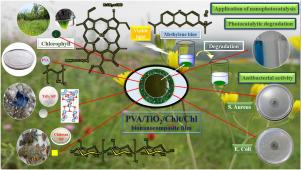Journal of Photochemistry and Photobiology A: Chemistry ( IF 4.3 ) Pub Date : 2020-09-12 , DOI: 10.1016/j.jphotochem.2020.112906 Vahhab Soltaninejad , Ali Maleki

|
In this study, using the chitosan (Chi), and poly(vinyl alcohol) (PVA) as a matrix for loading TiO2 nanoparticles (NPs), and the chlorophyll (Chl) as a natural light photocatalyst, provided the new, and efficient photocatalyst (PVA/TiO2/Chi/Chl). The TiO2 NPs and chlorophyll were applied to modify the PVA/Chi, and use as an effective nano-photocatalyst for degradation of methylene blue (MB), 4-chlorophenol (4-CP), and Congo red (CR) for the first time which shows efficiently promoted the separation of electron-hole pairs to enhance the photocatalytic activity. The degradation of MB was examined in the presence and absence of visible light. Also, the various contact time and the synergic effect of the different components of the bionanocomposite were studied. The high efficiency (96%) was achieved under visible-light irradiation (LED lamp 70 W by λ is 425 nm) at 60 min. The present bionanocomposite was identified by Fourier-transform infrared (FT-IR) spectra, field-emission scanning electron microscopy (FE-SEM) image, X-ray diffraction (XRD) pattern, and energy-dispersive X-ray (EDX), and photoluminescence (PL) analyses. Also, the antibacterial properties of PVA/TiO2/Chi/Chl as a distinctive feature were examined by the agar disk diffusion and colony counter method. The zone of inhibition for both S. aureus and E. coli bacteria were around 2.08 (±0.02), and 1.98 (±0.02), respectively. The colony counter was checked in the presence and the absence of visible light. Bacterial contamination presents serious risks to human health, therefore the prominent antimicrobial capability bionanocomposite inhibits the growth of both S. aureus, and E. coli bacteria under LED light irradiation. The use of green, and available materials, easy synthetic process, simple extraction method, eco-friendly protocol, high removal efficiency, and noticeable antibacterial properties are advantageous of the present work.
中文翻译:

通过光催化能力和在可见光下的抗菌活性,绿色环保的生物纳米复合膜(聚乙烯醇/ TiO 2 /壳聚糖/叶绿素)
在这项研究中,使用壳聚糖(Chi)和聚乙烯醇(PVA)作为负载TiO 2纳米颗粒(NPs)的基质,以及叶绿素(Chl)作为自然光光催化剂,提供了新的,高效的光催化剂(PVA / TiO 2 / Chi / Chl)。TiO 2NP和叶绿素被用于修饰PVA / Chi,并首次用作降解亚甲基蓝(MB),4-氯苯酚(4-CP)和刚果红(CR)的有效纳米光催化剂,这表明有效地促进了电子-空穴对的分离,从而增强了光催化活性。在存在和不存在可见光的情况下检查MB的降解。此外,还研究了生物纳米复合材料不同组分的各种接触时间和协同作用。在60分钟的可见光照射下(λ的LED灯70 W为425 nm)实现了高效率(96%)。通过傅立叶变换红外(FT-IR)光谱,场发射扫描电子显微镜(FE-SEM)图像,X射线衍射(XRD)图案和能量色散X射线(EDX)鉴定了目前的生物纳米复合材料,和光致发光(PL)分析。此外,PVA / TiO的抗菌特性通过琼脂圆盘扩散和菌落计数法检查了2 / Chi / Chl的独特特征。金黄色葡萄球菌和大肠杆菌的抑制区分别约为2.08(±0.02)和1.98(±0.02)。在有无可见光的情况下检查菌落计数器。细菌污染对人体健康构成严重威胁,因此,卓越的抗生生物合成能力抑制了金黄色葡萄球菌和大肠杆菌的生长。LED灯照射下的细菌。使用绿色且可用的材料,易于合成的过程,简单的提取方法,环保协议,高去除效率和显着的抗菌性能是本工作的优势。


























 京公网安备 11010802027423号
京公网安备 11010802027423号